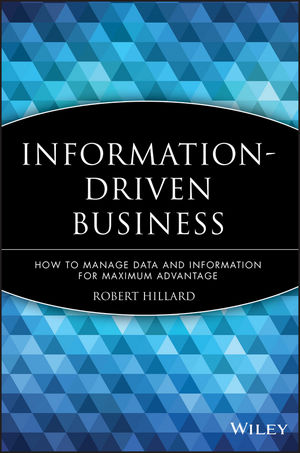Information-Driven Business: How to Manage Data and Information for Maximum AdvantageISBN: 978-0-470-62577-4
Hardcover
240 pages
August 2010
 This is a Print-on-Demand title. It will be printed specifically to fill your order. Please allow an additional 10-15 days delivery time. The book is not returnable.
|
||||||
Preface xiii
Acknowledgments xv
Chapter 1: Understanding the Information Economy 1
Did the Internet Create the Information Economy? 2
Origins of Electronic Data Storage 2
Stocks and Flows 3
Business Data 4
Changing Business Models 5
Information Sharing versus Infrastructure Sharing 6
Governing the New Business 7
Success in the Information Economy 8
Notes 9
Chapter 2: The Language of Information 10
Structured Query Language 13
Statistics 14
XQuery Language 15
Spreadsheets 15
Documents and Web Pages 16
Knowledge, Communications, and Information Theory 17
Notes 18
Chapter 3: Information Governance 19
Information Currency 19
Economic Value of Data 21
Goals of Information Governance 23
Organizational Models 24
Ownership of Information 26
Strategic Value Models 27
Repackaging of Information 30
Life Cycle 31
Notes 32
Chapter 4: Describing Structured Data 33
Networks and Graphs 33
Brief Introduction to Graphs 35
Relational Modeling 37
Relational Concepts 38
Cardinality and Entity-Relationship Diagrams 39
Normalization 40
Impact of Time and Date on Relational Models 49
Applying Graph Theory to Data Models 51
Directed Graphs 52
Normalized Models 53
Note 54
Chapter 5: Small Worlds Business Measure of Data 55
Small Worlds 55
Measuring the Problem and Solution 56
Abstracting Information as a Graph 57
Metrics 58
Interpreting the Results 60
Navigating the Information Graph 61
Information Relationships Quickly Get Complex 62
Using the Technique 64
Note 65
Chapter 6: Measuring the Quantity of Information 66
Definition of Information 66
Thermal Entropy 67
Information Entropy 68
Entropy versus Storage 70
Enterprise Information Entropy 73
Decision Entropy 76
Conclusion and Application 78
Notes 78
Chapter 7: Describing the Enterprise 79
Size of the Undertaking 79
Enterprise Data Models Are All or Nothing 80
The Data Model as a Panacea 81
Metadata 82
The Metadata Solution 83
Master Data versus Metadata 84
The Metadata Model 85
XML Taxonomies 87
Metadata Standards 87
Collaborative Metadata 88
Metadata Technology 90
Data Quality Metadata 91
History 91
Executive Buy-in 92
Notes 93
Chapter 8: A Model for Computing Based on Information Search 94
Function-Centric Applications 95
An Information-Centric Business 96
Enterprise Search 97
Security 98
Metadata Search Repository 98
Building the Extracts 100
The Result 100
Note 102
Chapter 9: Complexity, Chaos, and System Dynamics 103
Early Information Management 103
Simple Spreadsheets 104
Complexity 105
Chaos Theory 105
Why Information Is Complex 106
Extending a Prototype 110
System Dynamics 112
Data as an Algorithm 116
Virtual Models and Integration 118
Chaos or Complexity 119
Notes 120
Chapter 10: Comparing Data Warehouse Architectures 121
Data Warehousing 121
Contrasting the Inmon and Kimball Approaches 122
Quantity Implications 123
Usability Implications 125
Historical Data 132
Summary 133
Notes 134
Chapter 11: Layered View of Information 135
Information Layers 136
Are They Real? 137
Turning the Layers into an Architecture 141
The User Interface 143
Selling the Architecture 144
Chapter 12: Master Data Management 146
Publish and Subscribe 146
About Time 148
Granularity, Terminology, and Hierarchies 148
Rule 1: Consistent Terminology 149
Rule 2: Everyone Owns the Hierarchies 150
Rule 3: Consistent Granularity 150
Reconciling Inconsistencies 151
Slowly Changing Dimensions 151
Customer Data Integration 153
Extending the Metadata Model 153
Technology 155
Chapter 13: Information and Data Quality 156
Spreadsheets 156
Referencing 157
Fit for Purpose 158
Measuring Structured Data Quality 160
A Scorecard 164
Metadata Quality 164
Extended Metadata Model 165
Notes 166
Chapter 14: Security 167
Cryptography 167
Public Key Cryptography 169
Applying PKI 170
Predicting the Unpredictable 172
Protecting an Individual’s Right to Privacy 172
Securing the Content versus Securing the Reference 175
Chapter 15: Opening Up to the Crowd 176
A Taxonomy for the Future 177
Populating the Stakeholder Attributes 179
Reducing E-mail Traffic within Projects 179
Managing Customer E-mail 180
General E-mail 180
Preparing for the Unknown 181
Third-Party Data Charters 182
Information Is Dynamic 183
Power of the Crowd Can Improve Your Data Quality 183
Note 184
Chapter 16: Building Incremental Knowledge 185
Bayesian Probabilities 187
Information from Processes 188
The MIT Beer Game 192
Hypothesis Testing and Confidence Levels 193
Business Activity Monitoring 195
Note 196
Chapter 17: Enterprise Information Architecture 197
Web Site Information Architecture 198
Extending the Information Architecture 198
Business Context 199
Users 199
Content 200
Top-Down/Bottom-Up 200
Presentation Format 201
Project Resourcing 201
Information to Support Decision Making 203
Notes 204
Looking to the Future 205
About the Author 209
Index 211



